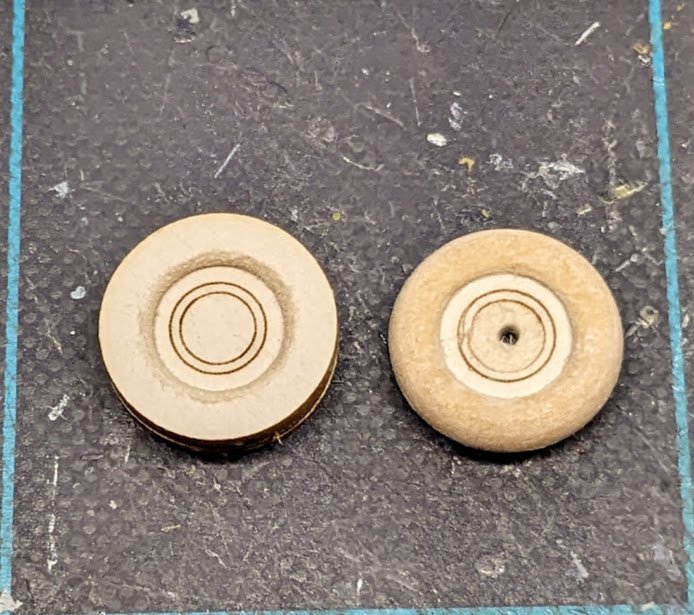-
Posts
10,529 -
Joined
-
Last visited
Content Type
Profiles
Forums
Gallery
Events
Everything posted by ccoyle
-
I am making agonizingly slow progress on this model, literally a couple of parts here and there every couple of days -- really having to push through on this one. In the meantime, I pulled the trigger on purchasing two additional Halinski kits to add to my stash, a Kawanishi N1K2-J Shiden-Kai (George) and a Messerschmitt Bf-109E-7/Trop. Both kits have been sold out at Halinski's web site for ages, and I have been scouring the internet off and on for a couple of years now in search of the N1K2-J. I knew of one web site that had that kit, but their shipping charges are astronomical, so I held out while looking for a cheaper source -- never did find one. When I recently saw that the expensive shop still has a copy, I decided to order it in spite of the stiff shipping charge. I added the 109E-7 to defray some of the cost and added laser-cut frames and a canopy to complete the deal (the site didn't have those items for the Kawanishi, but Halinski still has them). Let the waiting begin . . .
-
Congrats! I always love a good working boat.
- 18 replies
-
- Pot Pie Skiff
- Wye River Models
-
(and 1 more)
Tagged with:
-
Welcome aboard!
-
Beautiful -- but your finished model should really be displayed in the gallery.
-
Your work has paid off handsomely! Congratulations!
- 602 replies
-
- Flying Fish
- Model Shipways
-
(and 2 more)
Tagged with:
-
Looking good! I look forward to seeing her in her case.
- 21 replies
-
- Swift
- Artesania Latina
-
(and 2 more)
Tagged with:
-
I should add that not all acrylic paints are created equally. I use cheap, craft store paints for my card models, and for that purpose the coarse pigments used in such paints are not an issue. For wooden models, I recommend that you use acrylics specifically formulated for models -- they have finer pigments and will thus produce smoother finishes.
-
Been almost a year now, so time to give this message a bump! Take heed, please! This means that @Old Rentner, @ExPat , @Начинающий судомоделист, @clearway, and @Rvandg: YOU ARE CURRENTLY AT RISK OF HAVING YOUR LOOSE GALLERY IMAGES DELETED. Please move them into albums soon! If you need help with creating an album, contact a moderator. Thank you!
-
Wow, very nice! Having the persistence to build all those oars is a stunning achievement in itself!
- 510 replies
-
- reale de france
- corel
-
(and 1 more)
Tagged with:
-
Well, I got a wheel (singular) shaped. Each main gear wheel consists of four laminated disks. After gluing one up, I drill a hole through the center and use my Dremel tool to sand it to approximately the correct shape. After soaking it in some thin CA, I lightly sand it smooth. Here's a before-and-after: Don't worry -- the gaping holes get covered by paper hubs.
About us
Modelshipworld - Advancing Ship Modeling through Research
SSL Secured
Your security is important for us so this Website is SSL-Secured
NRG Mailing Address
Nautical Research Guild
237 South Lincoln Street
Westmont IL, 60559-1917
Model Ship World ® and the MSW logo are Registered Trademarks, and belong to the Nautical Research Guild (United States Patent and Trademark Office: No. 6,929,264 & No. 6,929,274, registered Dec. 20, 2022)
Helpful Links
About the NRG
If you enjoy building ship models that are historically accurate as well as beautiful, then The Nautical Research Guild (NRG) is just right for you.
The Guild is a non-profit educational organization whose mission is to “Advance Ship Modeling Through Research”. We provide support to our members in their efforts to raise the quality of their model ships.
The Nautical Research Guild has published our world-renowned quarterly magazine, The Nautical Research Journal, since 1955. The pages of the Journal are full of articles by accomplished ship modelers who show you how they create those exquisite details on their models, and by maritime historians who show you the correct details to build. The Journal is available in both print and digital editions. Go to the NRG web site (www.thenrg.org) to download a complimentary digital copy of the Journal. The NRG also publishes plan sets, books and compilations of back issues of the Journal and the former Ships in Scale and Model Ship Builder magazines.







